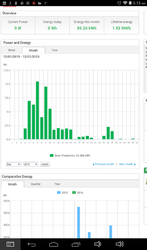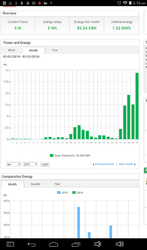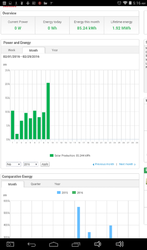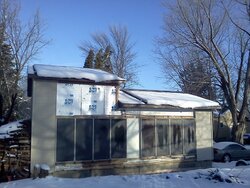Wondering if anyone has come up with a way to melt snow off PV panels during the winter? It's my first year with my system, I realize that there will be winter days without power of very little. But this winter has been strange and I only made 61kWh in Dec and 59kWh in Jan...so far this month after panels are completely clear of snow I have made 85kWh in 9 days.
Dec.

Jan.

Feb.

My system is 5.67KW and seems to be able to make 7-10kWh on days in Dec and Jan without snow on them. Thinking I am missing out on decent power those months, unless this year was odd from others. Seems the snow would clear after a day or two, but when it got cold ice formed on the panels and snow stayed on them for weeks at a time even with clear sunny days. Not much self-melting going on up there when its really cold.
Angle is around 23 degrees and they are 18 to 28 feet up. Not going to work with any snow rake that high up and I'm not going to climb up there every time it snows. Heat tape is out also.

I've had two ideas, both would require lots of labor again (I installed the racking and panels myself) but cost little to run if it works. Plus I already have nearly everything already laying around.
1. slinky coil pex tubing underneath each panel and pump hot water through them...hopefully raising the temp enough to just melt the snow enough so they self-shed. Hot water would be supplied by the hot water panels on the wall...pump would require 40 watts until the snow slides off. No heating costs.
Cons: would be making each coil and finding a way to attach them under each panel and the somewhat complex plumbing. Maybe it would require a sheet of 1/2" foil faced foam insulation attached to the frames to get enough heat? Would pex hold up for years under the panels? Paint the tubing maybe for UV protection?
Pros: No holes in roof...could pipe through the wall. Best chance of working I believe.
2. Install some roof vents and attach flex duct to the back and blow hot air under the panels. Hot air would be supplied by a wood boiler heating coil and furnace fan. Hot water would be suppied again by the hot water panels on the South wall. Fan would require more power and you would still need the circulator pump.
Cons: I'm not sure this would work without 'sealing' the array to the roof somehow and sealing the gaps between the panels in order to retain enough of the hot air to melt the snow enough in order to self-shed. would need to purchase the roof vents and would require holes in the roof.
Pros: Wouldn't require removing every panel.
Both ways I could use cold water in the summer from an unused, already installed, 2 ton slinky ground loop to some what cool the panels possibly...again the first idea would require the least power to run, maybe 80 or 100 watts for 2 circulator pumps. May not be worth the power cost of cooling effect...but its an idea.
Thoughts? Maybe I'm suffering from cabin fever and just need a project.
Dec.

Jan.

Feb.

My system is 5.67KW and seems to be able to make 7-10kWh on days in Dec and Jan without snow on them. Thinking I am missing out on decent power those months, unless this year was odd from others. Seems the snow would clear after a day or two, but when it got cold ice formed on the panels and snow stayed on them for weeks at a time even with clear sunny days. Not much self-melting going on up there when its really cold.
Angle is around 23 degrees and they are 18 to 28 feet up. Not going to work with any snow rake that high up and I'm not going to climb up there every time it snows. Heat tape is out also.

I've had two ideas, both would require lots of labor again (I installed the racking and panels myself) but cost little to run if it works. Plus I already have nearly everything already laying around.
1. slinky coil pex tubing underneath each panel and pump hot water through them...hopefully raising the temp enough to just melt the snow enough so they self-shed. Hot water would be supplied by the hot water panels on the wall...pump would require 40 watts until the snow slides off. No heating costs.
Cons: would be making each coil and finding a way to attach them under each panel and the somewhat complex plumbing. Maybe it would require a sheet of 1/2" foil faced foam insulation attached to the frames to get enough heat? Would pex hold up for years under the panels? Paint the tubing maybe for UV protection?
Pros: No holes in roof...could pipe through the wall. Best chance of working I believe.
2. Install some roof vents and attach flex duct to the back and blow hot air under the panels. Hot air would be supplied by a wood boiler heating coil and furnace fan. Hot water would be suppied again by the hot water panels on the South wall. Fan would require more power and you would still need the circulator pump.
Cons: I'm not sure this would work without 'sealing' the array to the roof somehow and sealing the gaps between the panels in order to retain enough of the hot air to melt the snow enough in order to self-shed. would need to purchase the roof vents and would require holes in the roof.
Pros: Wouldn't require removing every panel.
Both ways I could use cold water in the summer from an unused, already installed, 2 ton slinky ground loop to some what cool the panels possibly...again the first idea would require the least power to run, maybe 80 or 100 watts for 2 circulator pumps. May not be worth the power cost of cooling effect...but its an idea.
Thoughts? Maybe I'm suffering from cabin fever and just need a project.





